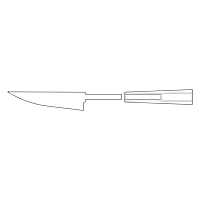Knife types
This page is designed as a guide to help you choose a knife. You will find the main types of knives, bevel grind type (blade geometry), steel types, handle types and handle materials.
We can then discuss it and design together your ideal knife.
Options presented below are not exhaustive. Everything is customizable: shape, dimensions, bevel grind type, handle type, materials, personalized engraving…
CHEF'S KNIFE
Chef’s knife is the essential knife, perfect for mincing, slicing, chiseling, chopping meat, fish, vegetables, fruits…
Blade length is usually between 16 cm (6 5/16th”) and 30 cm (11 13/16th”). 20-21 cm (8”) being a recommended size for most uses.
European style
The pronounced curvature of the cutting edge (belly) allows for an effective rock-chop motion for mincing, as taught in Western cooking schools, but is less suited to vertical push/pull cuts.


Gyuto
It is the Japanese version of the European chef's knife. The curvature of the cutting edge is less pronounced than on European knives, you can still make rock-chop motion cuts, but the shape is more designed for making vertical push/pull cuts.
K-tip (ou Kiritsuke)
Characterized by its beveled tip allowing even more precise cuts, this knife is very similar to the gyuto or the European chef's knife. The curvature of the cutting edge is less pronounced than on European knives, you can still make rock-chop motion cuts, but the shape is more designed for making vertical push/pull cuts.


Santoku
Characterized by its pronounced dropping point and its generally shorter blade: 16 cm (6 5/16th”) to 18 cm (7 1/16th”) which makes it very easy to use, this knife is very similar to the gyuto or the European chef's knife. The curvature of the cutting edge is less pronounced than on European knives, you can still make rock-chop motion cuts, but the shape is more designed for making vertical push/pull cuts.
Paring / Table knife
Another essential knife in the kitchen, the paring knife is small, handy, and allows multiple precision tasks that would be difficult or dangerous with a large blade. Blade length is generally between 6 cm (2 3/8th”) and 12 cm (4 3/4th”).


Petty knife
Halfway between a chef's knife and a paring knife, blade length is generally between 12 cm (4 3/4th”) and 16 cm (6 5/16th”).
It is a versatile knife, which can allow precision work, and possibly be used to cut poultry, debone, or even to fillet small fish.
Vegetable knife Nakiri
Although resembling a cleaver, this knife is designed primarily for cutting vegetables and fruits. Blade length is generally between 15 cm (5 15/16th”) and 18 cm (7 1/16th”), it is thin with a razor edge and is intended to make vertical push cuts. The tip is slightly rounded to allow the rear of the blade to be raised without planting the tip into the cutting board rather than to allow rock-chop motion cut. The wide blade also allows to move food.


Slicer
At the crossroads between a butcher knife, a slicer or slicing knife, this knife is particularly suitable for cutting meat, charcuterie, terrines, etc. Blade length is generally between 20 cm (7 7/8th”) and 30 cm (11 13/16th”), it is rigid, with a powerful cutting edge. However, it is not suitable for cutting bones.
Filet de sole / filleting knife
Knife designed for filleting fish or deboning meat. Blade length is generally between 17 cm (6 11/16th”) and 25 cm (9 13/16th”), it is thin and flexible and allows to cut fish fillets and meat into extremely thin slices.

Choose characteristics of your knife

